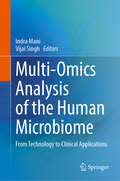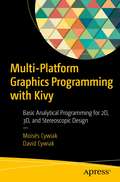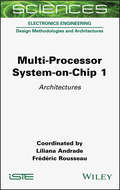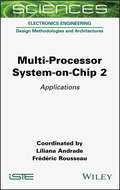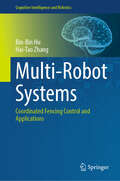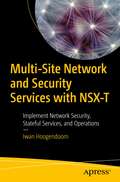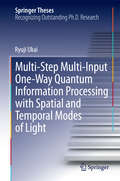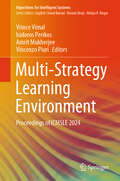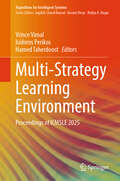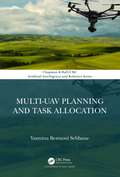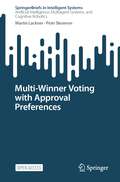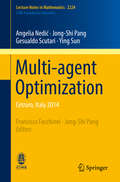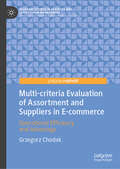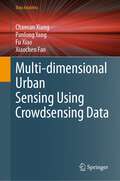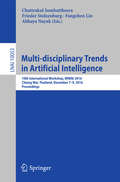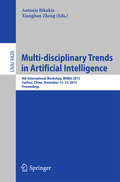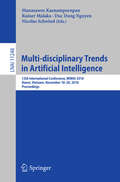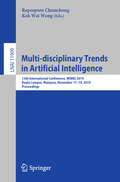- Table View
- List View
Multi-Omics Analysis of the Human Microbiome: From Technology to Clinical Applications
by Vijai Singh Indra ManiThis book introduces the rapidly evolving field of multi-omics in understanding the human microbiome. The book focuses on the technology used to generate multi-omics data, including advances in next-generation sequencing and other high-throughput methods. It also covers the application of artificial intelligence and machine learning algorithms to the analysis of multi-omics data, providing readers with an overview of the powerful computational tools that are driving innovation in this field. The chapter also explores the various bioinformatics databases and tools available for the analysis of multi-omics data. The book also delves into the application of multi-omics technology to the study of microbial diversity, including metagenomics, metatranscriptomics, and metaproteomics. The book also explores the use of these techniques to identify and characterize microbial communities in different environments, from the gut and oral microbiome to the skin microbiome and beyond. Towards theend, it focuses on the use of multi-omics in the study of microbial consortia, including mycology and the viral microbiome. The book also explores the potential of multi-omics to identify genes of biotechnological importance, providing readers with an understanding of the role that this technology could play in advancing biotech research. Finally, the book concludes with a discussion of the clinical applications of multi-omics technology, including its potential to identify disease biomarkers and develop personalized medicine approaches. Overall, this book provides readers with a comprehensive overview of this exciting field, highlighting the potential for multi-omics to transform our understanding of the microbial world.
Multi-Platform Graphics Programming with Kivy: Basic Analytical Programming for 2D, 3D, and Stereoscopic Design
by Moisés Cywiak David CywiakModern science requires computer graphics models to provide realistic visual renderings. Learning the appropriate programming tools for 2D and 3D modeling doesn’t have to be so difficult. This book reviews the best programming tools to achieve this and explains how to apply them to mobile platforms like Android. Multi-Platform Graphics Programming with Kivy provides a straightforward introductory approach for designing 2D, 3D, and stereoscopic applications, using analytical equations from vector algebra. Throughout the book you’ll look closely at this approach and develop scenes in Kivy, taking advantage of powerful mathematical functions for arrays by NumPy for Python. Unbuntu is used to develop the programs, which allows you to easily convert to Android platform. Each chapter contains step-by-step descriptions on each subject and provides complete program listings.What You’ll LearnWork with Kivy, a modern, powerful multi-platform graphics systemConvert and run programs on Android devicesProgram, fill faces, and rotate 2D and 3D polygonsApply the concepts of 2D and 3D applicationsDevelop stereoscopic scenesReview a straightforward introduction to 2D, 3D, and stereoscopic graphics applicationsUse simple analytical equations from vector algebraWho This Book Is ForThe primary audience is students and researchers in graphics programming with experience in analytical equations.
Multi-Processor System-on-Chip 1: Architectures
by Frederic Rousseau Liliana AndradeA Multi-Processor System-on-Chip (MPSoC) is the key component for complex applications. These applications put huge pressure on memory, communication devices and computing units. This book, presented in two volumes – Architectures and Applications – therefore celebrates the 20th anniversary of MPSoC, an interdisciplinary forum that focuses on multi-core and multi-processor hardware and software systems. It is this interdisciplinarity which has led to MPSoC bringing together experts in these fields from around the world, over the last two decades. Multi-Processor System-on-Chip 1 covers the key components of MPSoC: processors, memory, interconnect and interfaces. It describes advance features of these components and technologies to build efficient MPSoC architectures. All the main components are detailed: use of memory and their technology, communication support and consistency, and specific processor architectures for general purposes or for dedicated applications.
Multi-Processor System-on-Chip 2: Applications
by Frederic Rousseau Liliana AndradeA Multi-Processor System-on-Chip (MPSoC) is the key component for complex applications. These applications put huge pressure on memory, communication devices and computing units. This book, presented in two volumes – Architectures and Applications – therefore celebrates the 20th anniversary of MPSoC, an interdisciplinary forum that focuses on multi-core and multi-processor hardware and software systems. It is this interdisciplinarity which has led to MPSoC bringing together experts in these fields from around the world, over the last two decades. Multi-Processor System-on-Chip 2 covers application-specific MPSoC design, including compilers and architecture exploration. This second volume describes optimization methods, tools to optimize and port specific applications on MPSoC architectures. Details on compilation, power consumption and wireless communication are also presented, as well as examples of modeling frameworks and CAD tools. Explanations of specific platforms for automotive and real-time computing are also included.
Multi-Robot Systems: Coordinated Fencing Control and Applications (Cognitive Intelligence and Robotics)
by Hai-Tao Zhang Bin-Bin HuMulti-robot coordinated fencing, where a team of robots forms a protective formation around a target, has garnered significant attention and proven useful in practical applications such as area convoying. However, real-world scenarios often involve complex target characteristics, including varying dynamics and multiple targets, which can pose challenges in maintaining the formation. Additionally, due to sensor costs and environmental constraints, robots may only have access to directional constraint information, presenting further challenges. This book highlights cooperative fencing approaches for multi-robot systems and their practical applications to different unmanned surface (ground) vehicles, providing an overview of research trends and future directions in coordinated fencing. Firstly, a basic fencing controller using neighboring angle repulsion for a constant-velocity target is designed, laying the groundwork for complex fencing missions. Then, for more complex fencing with an evenly rotating formation, a distributed controller is developed using input-to-state stability, achieving coordinated fencing under intermittently varying topologies. For more complex varying-velocity targets, a distributed fencing controller based on output regulation theory is proposed. For general target fencing missions in both 2D and 3D, a formal long-term task execution framework is developed using control barrier functions. Moreover, unlike previous methods that rely on the relative position between the robot and the target, a distributed bearing-only fencing control algorithm based on the persistent-excitation condition is developed, requiring only comparatively inexpensive sensors. Finally, this exploration into the theory and application of coordinated fencing control provides guidelines for robust, efficient, and complex practical implementations of multi-robot missions.
Multi-Sensor and Multi-Temporal Remote Sensing: Specific Single Class Mapping
by Anil Kumar Priyadarshi Upadhyay Uttara SinghThis book elaborates fuzzy machine and deep learning models for single class mapping from multi-sensor, multi-temporal remote sensing images while handling mixed pixels and noise. It also covers the ways of pre-processing and spectral dimensionality reduction of temporal data. Further, it discusses the ‘individual sample as mean’ training approach to handle heterogeneity within a class. The appendix section of the book includes case studies such as mapping crop type, forest species, and stubble burnt paddy fields. Key features: Focuses on use of multi-sensor, multi-temporal data while handling spectral overlap between classes Discusses range of fuzzy/deep learning models capable to extract specific single class and separates noise Describes pre-processing while using spectral, textural, CBSI indices, and back scatter coefficient/Radar Vegetation Index (RVI) Discusses the role of training data to handle the heterogeneity within a class Supports multi-sensor and multi-temporal data processing through in-house SMIC software Includes case studies and practical applications for single class mapping This book is intended for graduate/postgraduate students, research scholars, and professionals working in environmental, geography, computer sciences, remote sensing, geoinformatics, forestry, agriculture, post-disaster, urban transition studies, and other related areas.
Multi-Site Network and Security Services with NSX-T: Implement Network Security, Stateful Services, and Operations
by Iwan HoogendoornKnow the basics of network security services and other stateful services such as NAT, gateway and distributed firewalls (L2-L7), virtual private networks (VPN), load balancing (LB), and IP address management. This book covers these network and security services and how NSX-T also offers integration and interoperability with various other products that are not only created by VMware, but are also referred by VMware as third-party integrated vendors.With the integration of VMware vRealize Automation, you can automate full application platforms consisting of multiple virtual machines with network and security services orchestrated and fully automated.From the operational perspective, this book provides best practices on how to configure logging, notification, and monitoring features and teaches you how to get the required visibility of not only your NSX-T platform but also your NSX-T-enabled network infrastructure.Another key part of this book is the explanation of multi-site capabilities and how network and security services can be offered across multiple on-premises locations with a single management pane. Interface with public cloud services also is included. The current position of NSX-T operation in on-premises private clouds and the position and integration with off-premises public clouds are covered as well.This book provides a good understanding of integrations with other software to bring the best out of NSX-T and offer even more features and capabilities.What You Will LearnUnderstand the NSX-T security firewall and advanced securityBecome familiar with NAT, DNS, DHCP, and load balancing featuresMonitor your NSX-T environmentBe aware of NSX-T authentication and authorization possibilitiesUnderstand integration with cloud automation platformsKnow what multi-cloud integrations are possible and how to integrate NSX-T with the public cloud Who This Book Is ForVirtualization administrators, system integrators
Multi-Step Multi-Input One-Way Quantum Information Processing with Spatial and Temporal Modes of Light
by Ryuji UkaiIn this thesis, the author develops for the first time an implementation methodology for arbitrary Gaussian operations using temporal-mode cluster states. The author also presents three experiments involving continuous-variable one-way quantum computations, where their non-classical nature is shown by observing entanglement at the outputs. The experimental basic structure of one-way quantum computation over two-mode input state is demonstrated by the controlled-Z gate and the optimum nonlocal gate experiments. Furthermore, the author proves that the operation can be controlled by the gain-tunable entangling gate experiment.
Multi-Strategy Learning Environment: Proceedings of ICMSLE 2024 (Algorithms for Intelligent Systems)
by Vincenzo Piuri Isidoros Perikos Vrince Vimal Amrit MukherjeeThe book presents selected papers from International Conference on Multi-Strategy Learning Environment (ICMSLE 2024), held at Graphic Era Hill University, Dehradun, India, during 12–13 January 2024. This book presents current research in machine learning techniques, deep learning theories and practices, interpretability and explainability of AI algorithms, game theory and learning, multi-strategy learning (MSL) in distributed and streaming environments, and adaptive data analysis and selective inference.
Multi-Strategy Learning Environment: Proceedings of ICMSLE 2025 (Algorithms for Intelligent Systems)
by Isidoros Perikos Vrince Vimal Hamed TaherdoostThis book presents selected papers from International Conference on Multi-Strategy Learning Environment (ICMSLE 2025), held at Graphic Era Hill University, Dehradun, India, during 26–27 February 2025. This book presents current research in machine learning techniques, deep learning theories and practices, interpretability and explainability of AI algorithms, game theory and learning, multi-strategy learning (MSL) in distributed and streaming environments, and adaptive data analysis and selective inference.
Multi-UAV Planning and Task Allocation (Chapman & Hall/CRC Artificial Intelligence and Robotics Series)
by Yasmina Bestaoui SebbaneMulti-robot systems are a major research topic in robotics. Designing, testing, and deploying aerial robots in the real world is a possibility due to recent technological advances. This book explores different aspects of cooperation in multiagent systems. It covers the team approach as well as deterministic decision-making. It also presents distributed receding horizon control, as well as conflict resolution, artificial potentials, and symbolic planning. The book also covers association with limited communications, as well as genetic algorithms and game theory reasoning. Multiagent decision-making and algorithms for optimal planning are also covered along with case studies. Key features: Provides a comprehensive introduction to multi-robot systems planning and task allocation Explores multi-robot aerial planning; flight planning; orienteering and coverage; and deployment, patrolling, and foraging Includes real-world case studies Treats different aspects of cooperation in multiagent systems Both scientists and practitioners in the field of robotics will find this text valuable.
Multi-Winner Voting with Approval Preferences (SpringerBriefs in Intelligent Systems)
by Martin Lackner Piotr SkowronFrom fundamental concepts and results to recent advances in computational social choice, this open access book provides a thorough and in-depth look at multi-winner voting based on approval preferences. The main focus is on axiomatic analysis, algorithmic results and several applications that are relevant in artificial intelligence, computer science and elections of any kind.What is the best way to select a set of candidates for a shortlist, for an executive committee, or for product recommendations? Multi-winner voting is the process of selecting a fixed-size set of candidates based on the preferences expressed by the voters. A wide variety of decision processes in settings ranging from politics (parliamentary elections) to the design of modern computer applications (collaborative filtering, dynamic Q&A platforms, diversity in search results, etc.) share the problem of identifying a representative subset of alternatives. The study of multi-winner voting provides the principled analysis of this task.Approval-based committee voting rules (in short: ABC rules) are multi-winner voting rules particularly suitable for practical use. Their usability is founded on the straightforward form in which the voters can express preferences: voters simply have to differentiate between approved and disapproved candidates. Proposals for ABC rules are numerous, some dating back to the late 19th century while others have been introduced only very recently. This book explains and discusses these rules, highlighting their individual strengths and weaknesses. With the help of this book, the reader will be able to choose a suitable ABC voting rule in a principled fashion, participate in, and be up to date with the ongoing research on this topic.
Multi-access Edge Computing: Software Development at the Network Edge (Textbooks in Telecommunication Engineering)
by Dario SabellaThe textbook covers the main aspects of Edge Computing, from a thorough look at the technology to the standards and industry associations working in the field. The book is conceived as a textbook for graduate students but also functions as a working guide for developers, engineers, and researchers. The book aims not only at providing a comprehensive technology and standard reference overview for students, but also useful research insights and practical exercises for edge software developers and investigators in the area (and for students looking to apply their skills). A particular emphasis is given Multi-access Edge Computing (MEC) as defined in European Telecommunications Standards Institute (ETSI), in relationship with other standard organizations like 3GPP, thus in alignment with the recent industry efforts to produce harmonized standards for edge computing leveraging both ETSI ISG MEC and 3GPP specifications. Practical examples of Edge Computing implementation from industry groups, associations, companies and edge developers, complete the book and make it useful for students entering the field. The book includes exercises, examples, and quizzes throughout.
Multi-agent Optimization: Cetraro, Italy 2014 (Lecture Notes in Mathematics #2224)
by Angelia Nedić Jong-Shi Pang Gesualdo Scutari Ying Sun Francisco FacchineiThis book contains three well-written research tutorials that inform the graduate reader about the forefront of current research in multi-agent optimization. These tutorials cover topics that have not yet found their way in standard books and offer the reader the unique opportunity to be guided by major researchers in the respective fields. Multi-agent optimization, lying at the intersection of classical optimization, game theory, and variational inequality theory, is at the forefront of modern optimization and has recently undergone a dramatic development. It seems timely to provide an overview that describes in detail ongoing research and important trends. This book concentrates on Distributed Optimization over Networks; Differential Variational Inequalities; and Advanced Decomposition Algorithms for Multi-agent Systems. This book will appeal to both mathematicians and mathematically oriented engineers and will be the source of inspiration for PhD students and researchers.
Multi-aspect Learning: Methods and Applications (Intelligent Systems Reference Library #242)
by Richi Nayak Khanh LuongThis book offers a detailed and comprehensive analysis of multi-aspect data learning, focusing especially on representation learning approaches for unsupervised machine learning. It covers state-of-the-art representation learning techniques for clustering and their applications in various domains. This is the first book to systematically review multi-aspect data learning, incorporating a range of concepts and applications. Additionally, it is the first to comprehensively investigate manifold learning for dimensionality reduction in multi-view data learning. The book presents the latest advances in matrix factorization, subspace clustering, spectral clustering and deep learning methods, with a particular emphasis on the challenges and characteristics of multi-aspect data. Each chapter includes a thorough discussion of state-of-the-art of multi-aspect data learning methods and important research gaps. The book provides readers with the necessary foundational knowledge to apply these methods to new domains and applications, as well as inspire new research in this emerging field.
Multi-body Dynamic Modeling of Multi-legged Robots (Cognitive Intelligence and Robotics)
by Dilip Kumar Pratihar Abhijit Mahapatra Shibendu Shekhar RoyThis book describes the development of an integrated approach for generating the path and gait of realistic hexapod robotic systems. It discusses in detail locomation with straight-ahead, crab and turning motion capabilities in varying terrains, like sloping surfaces, staircases, and various user-defined rough terrains. It also presents computer simulations and validation using Virtual Prototyping (VP) tools and real-world experiments. The book also explores improving solutions by applying the developed nonlinear, constrained inverse dynamics model of the system formulated as a coupled dynamical problem based on the Newton–Euler (NE) approach and taking into account realistic environmental conditions. The approach is developed on the basis of rigid multi-body modelling and the concept that there is no change in the configuration of the system in the short time span of collisions.
Multi-criteria Evaluation of Assortment and Suppliers in E-commerce: Operational Efficiency and Advantage (Palgrave Studies in Logistics and Supply Chain Management)
by Grzegorz ChodakIn a rapidly changing e-commerce environment, effective supplier selection and inventory management are critical to maintaining competitive advantage and operational efficiency. This book introduces innovative multi-criteria decision-making models (MCDMs) and improved inventory classification systems tailored specifically for online retail environments. Combining theory and research-based case studies, the book highlights the importance of comprehensive criteria in supplier and assortment evaluation and the application of artificial intelligence in optimising decision models. It provides valuable insights and practical solutions for improving supply chain performance and inventory management in the e-commerce sector. It will be of great interest to scholars and students of logistics and e-commerce and supply chain management.
Multi-dimensional Optical Storage
by Duanyi XuThis book presents principles and applications to expand the storage space from 2-D to 3-D and even multi-D, including gray scale, color (light with different wavelength), polarization and coherence of light. These actualize the improvements of density, capacity and data transfer rate for optical data storage. Moreover, the applied implementation technologies to make mass data storage devices are described systematically. Some new mediums, which have linear absorption characteristics for different wavelength and intensity to light with high sensitivity, are introduced for multi-wavelength and multi-level optical storage. This book can serve as a useful reference for researchers, engineers, graduate and undergraduate students in material science, information science and optics.
Multi-dimensional Urban Sensing Using Crowdsensing Data (Data Analytics)
by Panlong Yang Fu Xiao Chaocan Xiang Xiaochen FanChaocan Xiang is an Associate Professor at the College of Computer Science, Chongqing University, China. He received his bachelor’s degree and Ph.D. from Nanjing Institute of Communication Engineering, China, in 2009 and 2014, respectively. He subsequently studied at the University of Michigan-Ann Arbor in 2017 (supervised by Prof. Kang G. Shin, IEEE Life Fellow, ACM Fellow). His research interests mainly include UAVs/vehicle-based crowdsensing, urban computing, Internet of Things, Artificial Intelligence, and big data. He has published more than 50 papers, including over 20 in leading venues such as IEEE Transactions on Mobile Computing, IEEE Transactions on Parallel and Distributed Systems, IEEE INFOCOM, and ACM Ubicomp. He has received a best paper award and a best poster award at two international conferences. Panlong Yang is a full Professor at the University of Science and Technology of China. He has been supported by the NSF Jiangsu through a Distinguished Young Scholarship and was honored as a CCF Distinguished Lecturer in 2015. He has published over 150 papers, including 40 in CCF Class A. Since 2012, he has supervised 14 master’s and Ph.D. candidates, including two excellent dissertation winners in Jiangsu Province and the PLA education system. He has been supported by the National Key Development Project and NSFC projects. He has nominated by ACM MobiCom 2009 for the best demo honored mention awards, and won best paper awards at the IEEE MSN and MASS. He has served as general chair of BigCom and TPC chair of IEEE MSN. In addition, he has served as a TPC member of INFOCOM (CCF Class A) and an associate editor of the Journal of Communication of China. He is a Senior Member of the IEEE (2019). Fu Xiao received his Ph.D. in Computer Science and Technology from the Nanjing University of Science and Technology, Nanjing, China, in 2007. He is currently a Professor and Dean of the School of Computer, Nanjing University of Posts and Telecommunications. He has authored more than 60 papers in respected conference proceedings and journals, including IEEE INFOCOM, ACM Mobihoc, IEEE JASC, IEEE/ACM ToN, IEEE TPDS, IEEE TMC, etc. His main research interest is in the Internet of Things. He is a member of the IEEE Computer Society and the Association for Computing Machinery. Xiaochen Fan received his B.S. degree in Computer Science from Beijing Institute of Technology, Beijing, China, in 2013, and his Ph.D. from the University of Technology Sydney, NSW, Australia, in 2021. His research interests include mobile/pervasive computing, deep learning, and Internet of Things (IoT). He has published over 25 peer-reviewed papers in high-quality journals and IEEE/ACM international conference proceedings.
Multi-disciplinary Trends in Artificial Intelligence
by Chattrakul Sombattheera Frieder Stolzenburg Fangzhen Lin Abhaya NayakThis volume constitutes the refereed proceedings of the 5th Multi-disciplinary International Workshop On Artificial Intelligence, MIWAI 2011, held in Hyderabad, India, in December 2011. The 38 revised full papers presented were carefully reviewed and selected from 71 submissions. The papers cover the multifarious nature of the Artificial Intelligence research domain, ranging from theoretical to real world applications and address topics such as agent-based simulation, agent-oriented software engineering, agents and Web services, agent-based electronic commerce, auctions and markets, AI in video games, computer vision, constraint satisfaction, data mining, decision theory, distributed AI, e-commerce and AI, game theory, internet/www intelligence, industrial applications of AI, intelligent tutoring, knowledge representation and reasoning, machine learning, multi-agent planning and learning, multi-agent systems and their applications, multi-agent systems and evolving intelligence, natural language processing, neural networks, planning and scheduling, robotics, uncertainty in AI, and Web services.
Multi-disciplinary Trends in Artificial Intelligence
by Xianghan Zheng Antonis BikakisThis book constitutes the refereed conference proceedings of the 9th International Conference on Multi-disciplinary Trends in Artificial Intelligence, MIWAI 2015, held in Fuzhou, China, in November 2015. The 30 revised full papers presented together with 12 short papers were carefully reviewed and selected from 83 submissions. The papers feature a wide range of topics covering knowledge representation, reasoning, and management; multi-agent systems; data mining and machine learning; computer vision; robotics; AI in bioinformatics; AI in security and networks; and other AI applications.
Multi-disciplinary Trends in Artificial Intelligence: 10th International Workshop, MIWAI 2016, Chiang Mai, Thailand, December 7-9, 2016, Proceedings (Lecture Notes in Computer Science #10053)
by Chattrakul Sombattheera, Frieder Stolzenburg, Fangzhen Lin and Abhaya NayakThis book constitutes the refereed conference proceedings of the 10th International Conference on Multi-disciplinary Trends in Artificial Intelligence, MIWAI 2016, held in Chiang Mai, Thailand, in December 2016. The 22 revised full papers presented together with 5 short papers and 2 abstracts of invited talks were carefully reviewed and selected from 50 submissions. The workshop solicits papers from all areas of AI including cognitive science; computational intelligence; computational philosophy; game theory; machine learning; multi-agent systems; natural language; representation and reasoning; speech; vision and the web; as well as applications of AI in big data; bioinformatics; biometrics; decision support; e-commerce; image processing; analysis and retrieval; industrial applications; knowledge management; privacy; recommender systems; security; software engineering; spam filtering; surveillance; telecommunications; and web services.
Multi-disciplinary Trends in Artificial Intelligence: 12th International Conference, MIWAI 2018, Hanoi, Vietnam, November 18–20, 2018, Proceedings (Lecture Notes in Computer Science #11248)
by Rainer Malaka Manasawee Kaenampornpan Duc Dung Nguyen Nicolas SchwindThis book constitutes the refereed conference proceedings of the 12th International Conference on Multi-disciplinary Trends in Artificial Intelligence, MIWAI 2018, held in Hanoi, Vietnam, in November 2018. The 16 full papers presented together with 9 short papers were carefully reviewed and selected from 65 submissions. They are organized in the following topical sections: control, planning and scheduling, pattern recognition, knowledge mining, software applications, strategy games and others.
Multi-disciplinary Trends in Artificial Intelligence: 13th International Conference, MIWAI 2019, Kuala Lumpur, Malaysia, November 17–19, 2019, Proceedings (Lecture Notes in Computer Science #11909)
by Kok Wai Wong Rapeeporn ChamchongThis book constitutes the refereed proceedings of the 13th International Conference on Multi-disciplinary Trends in Artificial Intelligence, MIWAI 2019, held in Kuala Lumpur, Malaysia, in November 2019.The 19 full papers and 6 short papers presented were carefully reviewed and selected from 53 submissions. They cover a wide range of topics in theory, methods, and tools in AI sub-areas such as cognitive science, computational philosophy, computational intelligence, game theory, machine learning, multi-agent systems, natural language, representation and reasoning, data mining, speech, computer vision and the Web as well as their applications in big data, bioinformatics, biometrics, decision support, knowledge management, privacy, recommender systems, security, software engineering, spam filtering, surveillance, telecommunications, Web services, and IoT.
Multi-disciplinary Trends in Artificial Intelligence: 14th International Conference, MIWAI 2021, Virtual Event, July 2–3, 2021, Proceedings (Lecture Notes in Computer Science #12832)
by Junmo Kim Phatthanaphong Chomphuwiset Pornntiwa PawaraThis book constitutes the refereed proceedings of the 14th International Conference on Multi-disciplinary Trends in Artificial Intelligence, MIWAI 2021, held online in July 2021.The 13 full papers and 3 short papers presented were carefully reviewed and selected from 33 submissions. They cover a wide range of topics in theory, methods, and tools in AI sub-areas such as cognitive science, computational philosophy, computational intelligence, game theory, machine learning, multi-agent systems, natural language, representation and reasoning, data mining, speech, computer vision and the Web as well as their applications in big data, bioinformatics, biometrics, decision support, knowledge management, privacy, recommender systems, security, software engineering, spam filtering, surveillance, telecommunications, Web services, and IoT.
